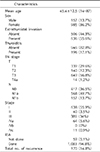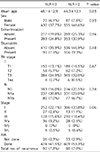Abstract
Purpose
Neutrophil-to-lymphocyte ratio (NLR) is a marker of systemic inflammatory response, which is inexpensive, easily calculated, and known to show correlation with prognosis of cancer. The aim of this study was to evaluate the relationship between NLR and prognosis of papillary thyroid carcinoma.
Methods
A total of 1,142 patients who underwent total thyroidectomy for papillary thyroid carcinoma between 1995~2005 at Asan Medical Center were enrolled in this study. Patients were categorized according to two groups based on NLR and clinico-pathological variables and disease survival were compared between the two groups.
Results
Median age of patients was 45.4 years, and the median follow-up period was 48 months. The cut-off value of NLR for prediction of disease-free survival (DFS) was 2. Comparison of DFS between two groups stratified by NLR (NLR ≤2, NLR>2) showed little statistical difference (P=0.48). After adjusting for risk (N stage), there was no significant difference according to N stage (N0: P=0.86, N1a: P=0.4, N1b: P=0.12).
Figures and Tables
Fig. 2
(A) Overall disease free survival (DFS) of pN10/Nx, pN1a and pN1b. (B) DFS according to the Neutrophil-to-lymphocyte ratio (NLR) in pN0 group. (C) DFS according to the NLR in pN1a group. (D) DFS according to the NLR in pN1b group.

Table 1
Characteristics of the patients

Table 2
Clinico-pathologic variables according to the NLR (percent)

References
1. Mantovani A, Allavena P, Sica A, Balkwill F. Cancer-related inflammation. Nature. 2008; 454:436–444.

2. Moore MM, Chua W, Charles KA, Clarke SJ. Inflammation and cancer: causes and consequences. Clin Pharmacol Ther. 2010; 87:504–508.

3. Bruckner HW, Lavin PT, Plaxe SC, Storch JA, Livstone EM. Absolute granulocyte, lymphocyte, and moncyte counts. Useful determinants of prognosis for patients with metastatic cancer of the stomach. JAMA. 1982; 247:1004–1006.

4. Satomi A, Murakami S, Ishida K, Mastuki M, Hashimoto T, Sonoda M. Significance of increased neutrophils in patients with advanced colorectal cancer. Acta Oncol. 1995; 34:69–73.

5. Gomez D, Farid S, Malik HZ, Young AL, Toogood GJ, Lodge JP, et al. Preoperative neutrophil-to-lymphocyte ratio as a prognostic predictor after curative resection for hepatocellular carcinoma. World J Surg. 2008; 32:1757–1762.

6. Ohno Y, Nakashima J, Ohori M, Hatano T, Tachibana M. Pretreatment neutrophil-to-lymphocyte ratio as an independent predictor of recurrence in patients with nonmetastatic renal cell carcinoma. J Urol. 2010; 184:873–878.

7. Chen J, Deng Q, Pan Y, He B, Ying H, Sun H, et al. Prognostic value of neutrophil-to-lymphocyte ratio in breast cancer. FEBS Open Bio. 2015; 5:502–507.

8. Bhatti I, Peacock O, Lloyd G, Larvin M, Hall RI. Preoperative hematologic markers as independent predictors of prognosis in resected pancreatic ductal adenocarcinoma: neutrophil-lymphocyte versus platelet-lymphocyte ratio. Am J Surg. 2010; 200:197–203.

9. Sarraf KM, Belcher E, Raevsky E, Nicholson AG, Goldstraw P, Lim E. Neutrophil/lymphocyte ratio and its association with survival after complete resection in non-small cell lung cancer. J Thorac Cardiovasc Surg. 2009; 137:425–428.

10. Kao SC, Pavlakis N, Harvie R, Vardy JL, Boyer MJ, van Zandwijk N, et al. High blood neutrophil-to-lymphocyte ratio is an indicator of poor prognosis in malignant mesothelioma patients undergoing systemic therapy. Clin Cancer Res. 2010; 16:5805–5813.

11. Noh H, Eomm M, Han A. Usefulness of pretreatment neutrophil to lymphocyte ratio in predicting disease-specific survival in breast cancer patients. J Breast Cancer. 2013; 16:55–59.

12. Svennevig JL, Lunde OC, Holter J, Bjørgsvik D. Lymphoid infiltration and prognosis in colorectal carcinoma. Br J Cancer. 1984; 49:375–377.

13. Okano K, Maeba T, Moroguchi A, Ishimura K, Karasawa Y, Izuishi K, et al. Lymphocytic infiltration surrounding liver metastases from colorectal cancer. J Surg Oncol. 2003; 82:28–33.

14. Kusumanto YH, Dam WA, Hospers GA, Meijer C, Mulder NH. Platelets and granulocytes, in particular the neutrophils, form important compartments for circulating vascular endothelial growth factor. Angiogenesis. 2003; 6:283–287.

15. Fondevila C, Metges JP, Fuster J, Grau JJ, Palacín A, Castells A, et al. p53 and VEGF expression are independent predictors of tumour recurrence and survival following curative resection of gastric cancer. Br J Cancer. 2004; 90:206–215.

16. Liu CL, Lee JJ, Liu TP, Chang YC, Hsu YC, Cheng SP. Blood neutrophil-to-lymphocyte ratio correlates with tumor size in patients with differentiated thyroid cancer. J Surg Oncol. 2013; 107:493–497.

17. Lang BH, Ng CP, Au KB, Wong KP, Wong KK, Wan KY. Does preoperative neutrophil lymphocyte ratio predict risk of recurrence and occult central nodal metastasis in papillary thyroid carcinoma? World J Surg. 2014; 38:2605–2612.

18. Han SW, Kang SY, Kim SK, Youn HJ, Jung SH. Clinical significance of blood neutrophil-to-lymphocyte ratio in patients with papillary thyroid carcinoma. Korean J Endocr Surg. 2014; 14:184–189.

19. Walsh SR, Cook EJ, Goulder F, Justin TA, Keeling NJ. Neutrophillymphocyte ratio as a prognostic factor in colorectal cancer. J Surg Oncol. 2005; 91:181–184.

20. Kelly ME, Khan A, Riaz M, Bolger JC, Bennani F, Khan W, et al. The utility of neutrophil-to-lymphocyte ratio as a severity predictor of acute appendicitis, length of hospital stay and postoperative complication rates. Dig Surg. 2015; 32:459–463.

21. Kahramanca S, Ozgehan G, Seker D, Gökce EI, Seker G, Tunç G, et al. Neutrophil-to-lymphocyte ratio as a predictor of acute appendicitis. Ulus Travma Acil Cerrahi Derg. 2014; 20:19–22.

22. Guclu H, Ozal SA, Pelitli Gurlu V, Birgul R. Elevated neutrophil lymphocyte ratio in recurrent optic neuritis. J Ophthalmol. 2015; 2015:758687.





 PDF
PDF ePub
ePub Citation
Citation Print
Print



 XML Download
XML Download